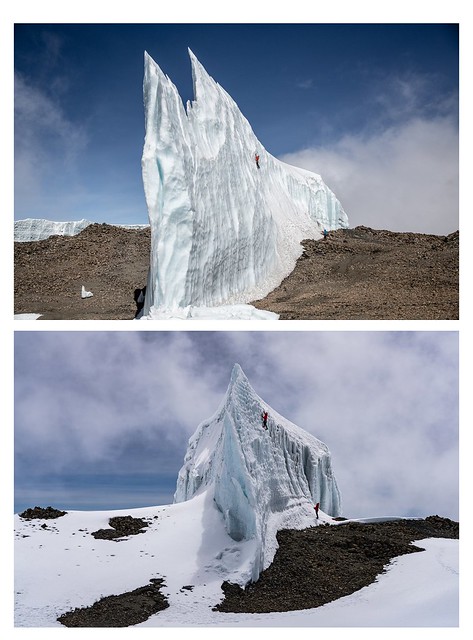World-renowned adventurer Will Gadd is having a rethink about his ice-climbing career and carbon footprint after discovering that his planned ascent of Tanzania’s Mount Kilimanjaro was no longer possible due to the extensive shrinking of its glaciers.
Gadd, the first person to climb a frozen Niagara Falls, had hoped to scale the remaining ice atop Africa’s highest peak with climbing partner Sarah Hueniken in February. But when they got there, they discovered that the extremely challenging Messner route they wanted to attempt – scaled only once since the 1980s – had lost so much ice it was impossible to ice-climb.
“The trip was an eye-opener for me,” says Gadd, who is helping to raise awareness about fragile mountain ecosystems and glacial melting as a United Nations Environment Programme (UNEP) Mountain Hero. “I’m really disappointed about missing the opportunity to climb the Messner Route, but I’ve come to realize that my carbon footprint, in some small way, contributed to the ice loss. It brings it home to me just how fast the climate is changing, especially in ultra-sensitive environments like glaciers in the tropics.”
In Africa, only Kilimanjaro, Mount Kenya and the Rwenzori range along the border of the Democratic Republic of Congo and Uganda have tropical glaciers. Their high altitudes of more than 5,000 metres above sea level mean temperatures are below freezing most of the year. However, glacier cover and mass have drastically diminished since the 19th century.
“Mountains matter,” says UNEP mountain ecosystems expert Musonda Mumba. “Given the unprecedented speed and magnitude of climate change in mountainous regions, adaptation strategies have to be developed and practical solutions carried out urgently.” She adds that UNEP is working to get mountains included in the post-2020 global biodiversity framework, which is due to replace the Strategic Plan for Biodiversity 2011-2020 and its Aichi Biodiversity Targets.
Kilimanjaro, a dormant volcano that rises 5,985 metres above sea level, is in many ways the poster child for the decline of tropical ice sheets.
During the 19th century, glaciers formed a ragged fringe around the Kibo caldera, the central cone of Kilimanjaro. Since then, about 90 per cent of the ice has been lost to melting and to sublimation, a process in which solid ice transitions directly to water vapour without first becoming liquid. Most of the remaining glaciers will disappear within a few years and the last ice will be gone within decades, says Douglas Hardy, a climate and glacier specialist at the University of Massachusetts Amherst who accompanied Gadd on the February expedition.
Through GPS mapping, Hardy determined that the Furtwängler Glacier, which Gadd climbed in 2014 and had planned to explore on his most recent trip, had lost 70 per cent of its ice mass between 2014 and 2020. The breaking up and shrinking of the glacier has left behind only thin walls of ice.
Research by Hardy and his collaborators indicates that Kilimanjaro’s glaciers are more sensitive to changes in snowfall, cloud cover and humidity than to small changes in air temperature. They believe global heating has sparked changes in the Indian Ocean – including tropical cyclones – altering weather patterns around the mountain and leading to the collapse of its glaciers.
On Gadd’s trip, conditions were snowier than normal for February, with bright white snow covering the summit (Ernest Hemingway once described the peak as “unbelievably white in the sun”). The glaciers are protected by the albedo effect: incoming solar energy is reflected by the snow, rather than absorbed by darker glacier ice surfaces and the surrounding rocks. If snow cover diminishes the rate of glacier melt could speed up further.
“The trip was an eye-opener for me. I’m really disappointed about missing the opportunity to climb The Messner Route, but I’ve come to realize that my carbon footprint, in some small way, contributed to the ice loss.”
Gadd and Hardy spent time discussing all these processes and witnessing their consequences for the glaciers. “I see subtle changes in the glaciers every time I am up there,” says Hardy, a regular visitor to Kilimanjaro, where he helped set up a weather station.
For Gadd however, the changes from nearly five years earlier were huge; some glaciers were nearly unrecognizable. That has prompted the Canadian to reconsider his globe-trotting ways.
“Climate change, together with this COVID-19 crisis, is making me think that from now on, I want to find fresh challenges closer to my home,” he says.
UNEP is collaborating with the International Climbing and Mountaineering Federation to boost environmental protection in mountainous areas. The planned work includes training mountain guides on sustainability issues in collaboration with the International Federation of Mountain Guides Associations. One example is working with the climbing and mountaineering community on reducing the amount of litter left in these fragile landscapes. A Memorandum of Understanding was signed between the two sides in February 2020.
Recently, UNEP and partners started to jointly implement the Adaptation at Altitude programme, which is funded by the Swiss Agency for Development and Cooperation. The objective is to improve the availability and use of mountain observation data, to strengthen regional exchange and collaboration and to establish a community of practice on climate change adaptation in mountains. In East Africa, UNEP supports strengthening the East African Community and building capacities at the local and regional levels for adaptation in mountains, including in the Kilimanjaro region.
For more information, please contact Will Gadd (williamgadd@gmail.com)
Matthias Jurek (matthias.jurek@un.org),or Musonda Mumba (Musonda.mumba@un.org)


















